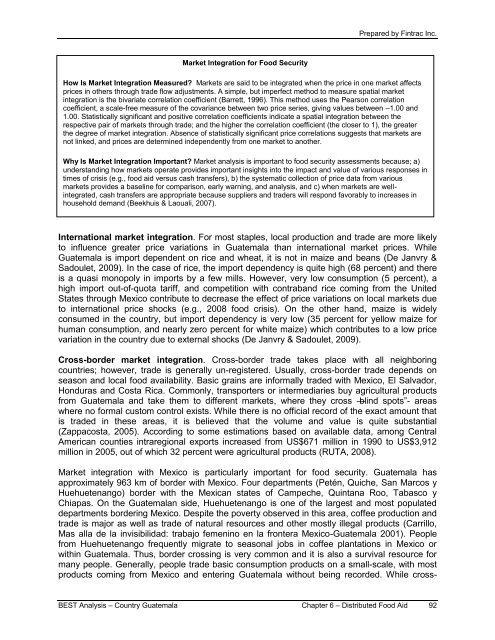usaid office of food for peace guatemala bellmon estimation
usaid office of food for peace guatemala bellmon estimation
usaid office of food for peace guatemala bellmon estimation
Create successful ePaper yourself
Turn your PDF publications into a flip-book with our unique Google optimized e-Paper software.
Market Integration <strong>for</strong> Food Security<br />
Prepared by Fintrac Inc.<br />
How Is Market Integration Measured? Markets are said to be integrated when the price in one market affects<br />
prices in others through trade flow adjustments. A simple, but imperfect method to measure spatial market<br />
integration is the bivariate correlation coefficient (Barrett, 1996). This method uses the Pearson correlation<br />
coefficient, a scale-free measure <strong>of</strong> the covariance between two price series, giving values between –1.00 and<br />
1.00. Statistically significant and positive correlation coefficients indicate a spatial integration between the<br />
respective pair <strong>of</strong> markets through trade; and the higher the correlation coefficient (the closer to 1), the greater<br />
the degree <strong>of</strong> market integration. Absence <strong>of</strong> statistically significant price correlations suggests that markets are<br />
not linked, and prices are determined independently from one market to another.<br />
Why Is Market Integration Important? Market analysis is important to <strong>food</strong> security assessments because; a)<br />
understanding how markets operate provides important insights into the impact and value <strong>of</strong> various responses in<br />
times <strong>of</strong> crisis (e.g., <strong>food</strong> aid versus cash transfers), b) the systematic collection <strong>of</strong> price data from various<br />
markets provides a baseline <strong>for</strong> comparison, early warning, and analysis, and c) when markets are wellintegrated,<br />
cash transfers are appropriate because suppliers and traders will respond favorably to increases in<br />
household demand (Beekhuis & Laouali, 2007).<br />
International market integration. For most staples, local production and trade are more likely<br />
to influence greater price variations in Guatemala than international market prices. While<br />
Guatemala is import dependent on rice and wheat, it is not in maize and beans (De Janvry &<br />
Sadoulet, 2009). In the case <strong>of</strong> rice, the import dependency is quite high (68 percent) and there<br />
is a quasi monopoly in imports by a few mills. However, very low consumption (5 percent), a<br />
high import out-<strong>of</strong>-quota tariff, and competition with contraband rice coming from the United<br />
States through Mexico contribute to decrease the effect <strong>of</strong> price variations on local markets due<br />
to international price shocks (e.g., 2008 <strong>food</strong> crisis). On the other hand, maize is widely<br />
consumed in the country, but import dependency is very low (35 percent <strong>for</strong> yellow maize <strong>for</strong><br />
human consumption, and nearly zero percent <strong>for</strong> white maize) which contributes to a low price<br />
variation in the country due to external shocks (De Janvry & Sadoulet, 2009).<br />
Cross-border market integration. Cross-border trade takes place with all neighboring<br />
countries; however, trade is generally un-registered. Usually, cross-border trade depends on<br />
season and local <strong>food</strong> availability. Basic grains are in<strong>for</strong>mally traded with Mexico, El Salvador,<br />
Honduras and Costa Rica. Commonly, transporters or intermediaries buy agricultural products<br />
from Guatemala and take them to different markets, where they cross ―blind spots‖- areas<br />
where no <strong>for</strong>mal custom control exists. While there is no <strong>of</strong>ficial record <strong>of</strong> the exact amount that<br />
is traded in these areas, it is believed that the volume and value is quite substantial<br />
(Zappacosta, 2005). According to some <strong>estimation</strong>s based on available data, among Central<br />
American counties intraregional exports increased from US$671 million in 1990 to US$3,912<br />
million in 2005, out <strong>of</strong> which 32 percent were agricultural products (RUTA, 2008).<br />
Market integration with Mexico is particularly important <strong>for</strong> <strong>food</strong> security. Guatemala has<br />
approximately 963 km <strong>of</strong> border with Mexico. Four departments (Petén, Quiche, San Marcos y<br />
Huehuetenango) border with the Mexican states <strong>of</strong> Campeche, Quintana Roo, Tabasco y<br />
Chiapas. On the Guatemalan side, Huehuetenango is one <strong>of</strong> the largest and most populated<br />
departments bordering Mexico. Despite the poverty observed in this area, c<strong>of</strong>fee production and<br />
trade is major as well as trade <strong>of</strong> natural resources and other mostly illegal products (Carrillo,<br />
Mas alla de la invisibilidad: trabajo femenino en la frontera Mexico-Guatemala 2001). People<br />
from Huehuetenango frequently migrate to seasonal jobs in c<strong>of</strong>fee plantations in Mexico or<br />
within Guatemala. Thus, border crossing is very common and it is also a survival resource <strong>for</strong><br />
many people. Generally, people trade basic consumption products on a small-scale, with most<br />
products coming from Mexico and entering Guatemala without being recorded. While cross-<br />
BEST Analysis – Country Guatemala Chapter 6 – Distributed Food Aid 92

















